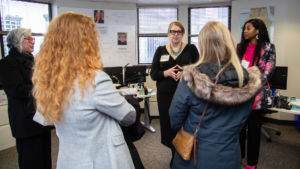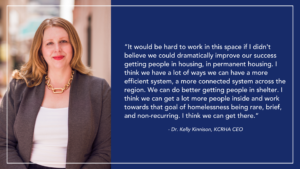We Are Facing A Great Need
We know that more than 53,000 people experienced homelessness in 2022. Without a significant change to our community response, modeling indicates this number will grow to nearly 62,000 people by 2028.
We must treat this emergency, like an emergency. Our community must create 18,200 new units of temporary housing to bring more people inside. By combining new and existing temporary housing units, and as people move through temporary housing and into permanent housing, we could serve an estimated 35,600 households each year.
That’s our job. And we have a lot of work to do.
KCRHA, working alongside governments, service providers, philanthropy and the private sector has made progress in its first year, but we still have a long way to go:
- We’ve resolved 13 encampment sites, including long-standing sites at Dearborn and in the Chinatown-International District.
- Through partnership on the State Right of Way Safety Initiative, 292+ individuals, couples, and families have moved inside to temporary or permanent housing.
- Through partnership with three Public Housing Authorities and service providers across King County, we helped nearly 1,400 households receive long term leases through new federally funded Emergency Housing Vouchers.
- More than 170 people previously unsheltered in Downtown Seattle and the Chinatown International District have moved into permanent housing, including many supported by a new program called Partnership for Zero.
- The regional approach is working, with five North King County cities signed on to pool funding with KCRHA and work underway to include additional cities in every sub-region.
- Over the course of 2022, more than 5,600 individuals, couples, and families moved from homelessness into permanent housing. And even more will move inside in 2023.
The Path Forward: Our 5-Year Plan to Dramatically Reduce Unsheltered Homelessness
If we are to meet the need of bringing more people inside each year, we must make changes to the system, optimize existing resources, and invest new resources where they can have the greatest impact.
Our 5-Year Plan outlines a three-part approach, bringing solutions to systems challenges we’ve faced at three levels:
SERVICE PROVIDERS: Improve outcomes at individual service providers, like outreach and shelter, by ensuring every provider has the staff, tools, and support to implement best practices.
NETWORK OF HOMELESSNESS SERVICES: Coordinate our network of service providers through shared data and accountability, ensuring that services are available across King County and that the needs of disproportionately impacted populations are met.
SYSTEM-TO-SYSTEM CONNECTIONS: Collaborate across systems—healthcare, housing, public safety, employment, education, and more—to prevent homelessness.
The activities listed in the full Plan provide a roadmap and set of action steps to achieve progress on each of these three levels, unifying and coordinating the homeless response system so that it is more transparent, accountable, and effective. The Plan is currently undergoing revisions, incorporating feedback from service providers and advocates, people with lived experience with homelessness, leaders in philanthropy, business, and government, and our community at large. It will be finalized in the month of May and voted on by our Governing Committee on June 1, 2023.
It Takes All of Us Working Together
We are making progress. But we have a long way to go.
We can only be successful if our whole community—government, businesses, philanthropy, service providers, nonprofits, and people like you—comes together around one shared vision and plan to dramatically reduce unsheltered homelessness.
Working together, we can solve this crisis. We are inviting you to join us.



